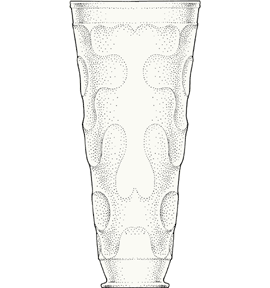- Glass Making in Roman Times
- Roman Wine: A Window on an Ancient Economy
- Roman Wine: Windows on a Lifestyle
- Fine Glassware in the Roman World
- Reuse of Images in the Art of Rogier van der Weyden
Properties of Glass

Faceted beaker from Pompeii
Mid 1st century A.D.
Ht.,17.0 cm

Globular jar with collared rim
Early 2nd century A.D.
Ht., 15.7 cm
Amid ancient texts there nestles a subtle reflection of how, over the period of the late 6th century B.C. to the mid 8th century A.D., inquiring minds came to grips with the distinctive physical and technical properties of glass. The philosophical insight of Aristotle gave way to the puzzlement of Lucretius; the empirical perceptiveness of Pliny gave way to the scientific certainty of Agricola:
"...for in some cases, if we saw we should not seek—not on the grounds that we knew by seeing, but that we grasped the universal by the seeing. For example, if we saw the glass [hyalos] to be perforated and the light coming through it, it would be clear why it does, even if seeing occurs separately for each piece of glass while comprehending grasps from one time that it is thus in every case." (Aristotle, Posterior Analytics I.31)
"But when the opposed object is bright and compact, as particularly a mirror [speculum], nothing happens of the sort; for the image cannot pass through as through glass [vitrum], nor again can they be broken; so much safety the smoothness never forgets to afford." (Lucretius, On the Nature of Things IV.150)
"...and yet glass globes [vitreae pilae] containing water become so hot when they face the sun that they can set clothes on fire. Pieces of broken glass can, when heated to a moderate temperature, be stuck together, but that is all. They can never again be completely melted except into globules separated from each other." (Pliny the Elder, Natural History XXXVI.199)
About halfway along that path to scientific understanding, the Romans created an industry out of a craft.
